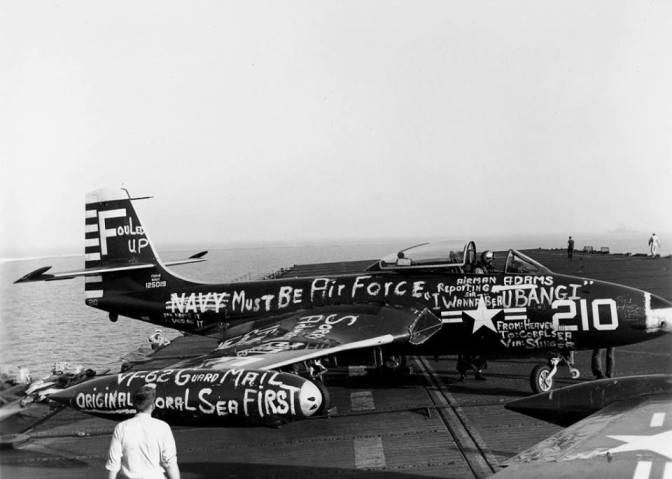Earlier today, we had posted this picture on Facebook of what happens to an aircraft that lands on the wrong aircraft carrier while at sea:
Doubtless to say, the pilot in question must’ve been the butt of ready room jokes for weeks or even months afterwards. But, thankfully for the pilot, he landed aboard a carrier that belonged to the same navy. Odd sentence right? Well, in 1942, during the Battle of the Coral Sea, a few Japanese pilots tried landing aboard a different carrier than the one they took off from. Here’s the thing, though: that carrier wasn’t a registered vessel with the Imperial Japanese Navy.
Coral Sea was the first ever engagement in history where aircraft carriers fought aircraft carriers. Of course, these hulking ships didn’t directly engage each other (heck, they weren’t even in visual range of the opposing forces) but rather used their aircraft to attack and defend. The final result for the Allied side was the scuttling of the USS Lexington (CV-2, aka the Lady Lex) after it sustained severe damage, the USS Yorktown (CV-5) taking heavy damage as well, along with a destroyer and a fleet oiler sunk. The Japanese were subject to larger losses with a carrier sunk, a larger fleet carrier sailing away battered and thoroughly beaten and a number of smaller vessels (in comparison to carriers, that is) either sunk or damaged beyond repair.
Before I carry on with the explaining this most bizarre event, it should be noted that Japanese officers in command of their battle group weren’t as ready for the fight as their American counterparts in that they didn’t possess the radar available to the Yorktown and Lady Lex. So when a certain Admiral Takagi launched a flight of dive and torpedo bombers to attack an American cruiser group in their path, they were quickly met by Grumman F4F Wildcats launched by the US carriers, which had quickly detected the incoming attack flight. This not only had the effect of scaring the daylights out of the Japanese pilots but also contributed to mass confusion among the Japanese strike flight, causing them to abandon the mission they were tasked with and scatter.
The Japanese pilots had no other option than to head back to their ships, lest they become fodder for the .50 caliber machine guns of the Wildcats. Dusk was already upon them and their situation wasn’t getting any better. A number of disoriented pilots, still reeling from the shock of the unexpected American interception, circled around looking for their carrier and found a flattop. Assuming it was one of their own, they entered into a landing pattern, signaling the landing officers on deck that they were preparing to touch down. As it turns out, the battle-weary pilots didn’t realize that they were about to land on the USS Yorktown. Truth be told, according to VF-42 pilot Lieutenant Junior Grade Elbert McCuskey, even American sailors were totally unwitting of what was unfolding:
“Everything was in a mess, with the Japanese planes and the American planes and the carriers all over the place. I couldn’t find my carrier, so I landed on an-other. I saw 3 Japanese planes circling with us, and thought they were part of a group from another carrier. I landed and was in the ready room when someone got wise that those 3 were Japanese.” [1]
As the first Japanese pilot in the pattern attempted to set his bomber down, he suddenly came to his senses while his engine entered the idling stage and he was drifting in for a textbook landing. Ramming his throttle forward, he jinked away at the last second with his (now even more confused) fellow dive and torpedo pilots following his lead. Their aircraft were unarmed as they had jettisoned their ordnance as was procedure prior to landing. American gunners aboard the Yorktown wised up immediately and began firing at anything in the air, even mistaking friendly Wildcats for targets. All in all, around 27 Japanese planes took off that day, only 18 returned to their [correct] carrier.
The following is a recollection from Bill Surgi, a midshipman aboard the Yorktown at the time of the incident:
“It happened at sunset. There was light in the western skies, and it was dark to the east. We on Yorktown were preparing to land our CAP (Combat Air Patrol) of F4F Wildcat fighters when a group of aircraft circled the task force sending blinker light signals that we did not recognise. This group of aircraft joined our landing pattern. Our LSO (Landing Signal Officer) would have been expecting to bring aboard the F4Fs of our CAP because they were the only aircraft expected at this time. The F4Fs had close in, retractable landing gear. The LSO sees an aircraft with wide spread, fixed landing gear coming into the landing pattern. It was a Japanese Aichi Type 99 “Val” dive bomber, so he waves it off, and the Japanese pilot took the wave off. Our skipper, Capt. Buckmaster, passed the word ‘stand by to repel boarders’. As the Japanese plane went by the port side, and the “meat ball” * was seen, all guns took him on. It was like fireworks, with tracers going into any aircraft that went by. I guess they got the idea we were not theirs! It was unusual to say the least, and we were on edge. In the general confusion, some of the F4Fs of our CAP flew through friendly fire. Ensign William. W. Barnes landed with his oil cooler shot up. He was ready to fight the plane handlers, wanting to know why we shot at him.” [2]
* Service slang for the Japanese national insignia on aircraft.
[1] The Argus (Melbourne) Tuesday 23 June 1942


Thank yoou for writing this
LikeLike